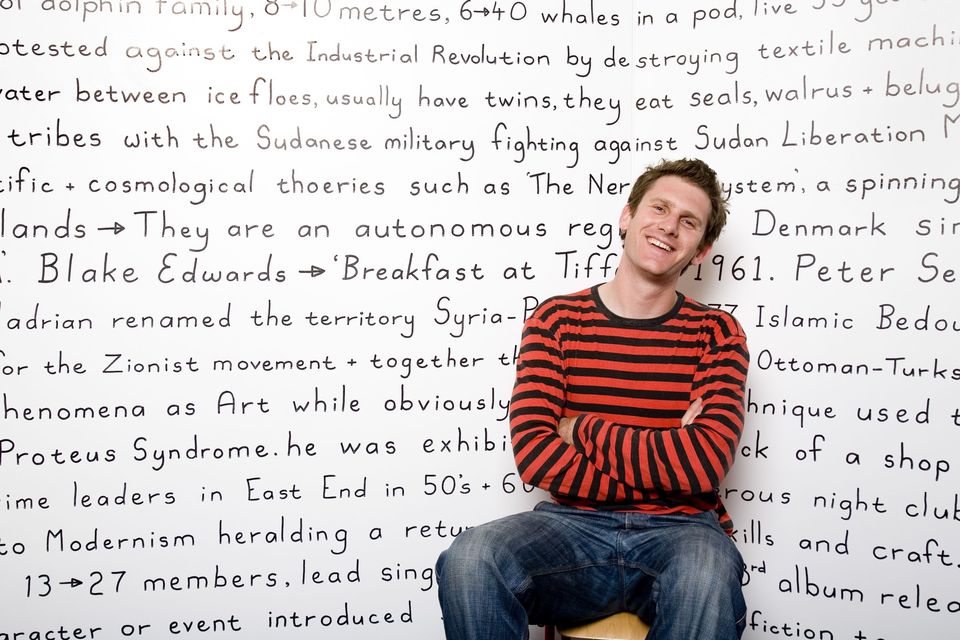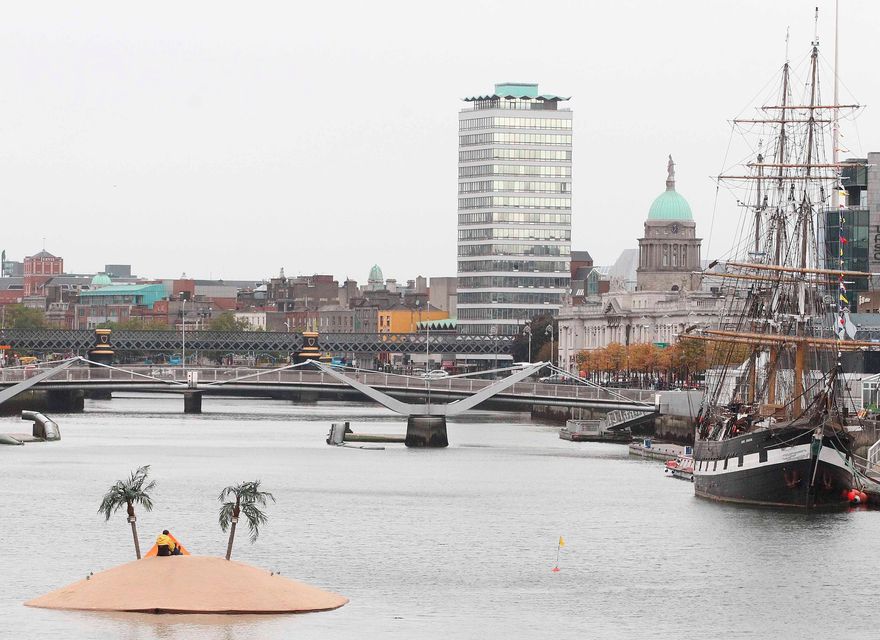The Liffey has always influenced generations of Dubliners and even had a direct influence on the naming of the city – Áth Cliath, the hurdled ford.
Fergal McCarthy, an accomplished Dublin-based artist, has created a map that celebrates the city’s storied waterway and its bridges.
His previous works have included living on a self-constructed island on the Liffey for a week.
That was back in 2011, when he created ‘No Man’s Land’ for the Dublin Fringe Festival, a floating pontoon in the middle of the river, complete with two palm trees.
His new exhibition, The Bridges of Dublin, features a jumbo version of his illustrated portrait of the Liffey and its bridges.
“I moved to Dublin in 2000. I can remember one day crossing the Liffey at sunset and stopping for the first time. I saw the sun setting behind the Guinness Factory,” Mr McCarthy said.
“I was wowed by this beauty. With the traffic being removed from the Quays, it’s this great opportunity for us to begin using this great space.
Part of Fergal McCarthy’s artwork illustrating the history of Dublin’s Liffey bridges
“I’m a primary school teacher as well as an artist, so I’m very used to kids looking at me when I’m teaching them history and they’re bored out of their heads.
“I’ve spent a couple of decades now as a teacher having enlivened lessons. I always go for humour and try to make things funnier than they are.
“I’ve put the people who designed the bridges and built them on a map, the names of the people they are named after, and I’ve tried to liven them up.
“You’ll see Samuel Beckett crossing his bridge, where there are three swans talking about Beckett. One says, ‘the Nobel Prize winning author finally got his bridge’.
“Another says, ‘it is the third writer to get a bridge’ and then the last one says, ‘the maestro of failure would approve’.
“With James Joyce, arguably our greatest writer, I try to be more playful. Nobody knows if it’s true or not, but when Joyce died he said that ‘Dublin will be written in my heart’.
“I’ve got this in the drawing and there’s a seagull flying above them saying, ‘oh, Joyce, always the drama queen’.
“The sculpture of Anna Livia used to be on O’Connell Street, but is now near Heuston station. I’ve put her back into the river she’s been named after. Right under Joyce’s Bridge.
Artist and teacher Fergal McCarthy
“The Mellows Bridge, a kangaroo crossed that in the 1700s. It had been brought back from Australia, and was being brought to the RDS as a spectacle. There’s a lot going on.”
Twenty four bridges help us to cross over the River Liffey, yet most of us would be hard pressed to name them all.
Some are named after revolutionaries like Rosie Hackett, others after Nobel laureates such as Samuel Beckett. Some are made of concrete, others of metal. But all of them have one thing in common: to unite Dublin, north and south.
“In the early 1900s the Ha’Penny [Bridge] was made free. It was originally a ferryman that had maybe three boats before there was a bridge there,” Mr McCarthy said.
“He would ferry people back and forth, maybe his little dock was unsafe, and people drowned. There was some catastrophe and he was forced into building this bridge.
“He had to give up the ferry service, so that’s why you had to pay half a penny to cross. When it first opened, around 400 people would cross it a day. Now it is in the region of 30,000 people every day.
“The Ha’Penny Bridge had the scourge of the lovelocks about 10 years ago where people would put their initials in a love heart on the padlock.
“There was a shop across the road that would sell them. The bridge at one stage began to sag from the weight, then all had to be removed.
“The Sean O’Casey Bridge, it was built in 2010, it opened and closed with a remote. The remote was lost very soon after it was built, and it took four more years before they managed to either find it or get a new remote control built.
Artist Fergal McCarthy lived on a man-made island in the middle of the Liffey as part of the Dublin Fringe Festival in 2011. Pic: Collins Photos
“Those bridges down in the Docklands, the Samuel Beckett Bridge, the Sean O’Casey Bridge, all rotate or open to allow boats through. But they almost never open because of the extra cost.
“Any ships that do come in dock east of the Samuel Beckett Bridge. It was built in Rotterdam and was sailed here on a barge. It took 36 hours to cross the English Channel. It was just dropped into place by a crane.
“Similarly, the Millennium Bridge was built in Carlow and brought on a single truck to Dublin and a crane dropped it into place.
“Currently the Rosie Hackett Bridge is the only bridge named after a female. There was a vote, and the other three options were all male.
“One of the bridges further down was the Queen Maeve Bridge for a while. It got renamed after a Republican hero of the Rising.
“The first bridge on the Liffey was called Sarah’s Bridge, after the wife of the Lord Lieutenant of Ireland. So, any women who got bridges were quickly renamed,” he added.
This Bridges of Dublin exhibition is on show now and will run until Sunday, November 17 in Dublin Port Company’s cultural hub, the Substation


